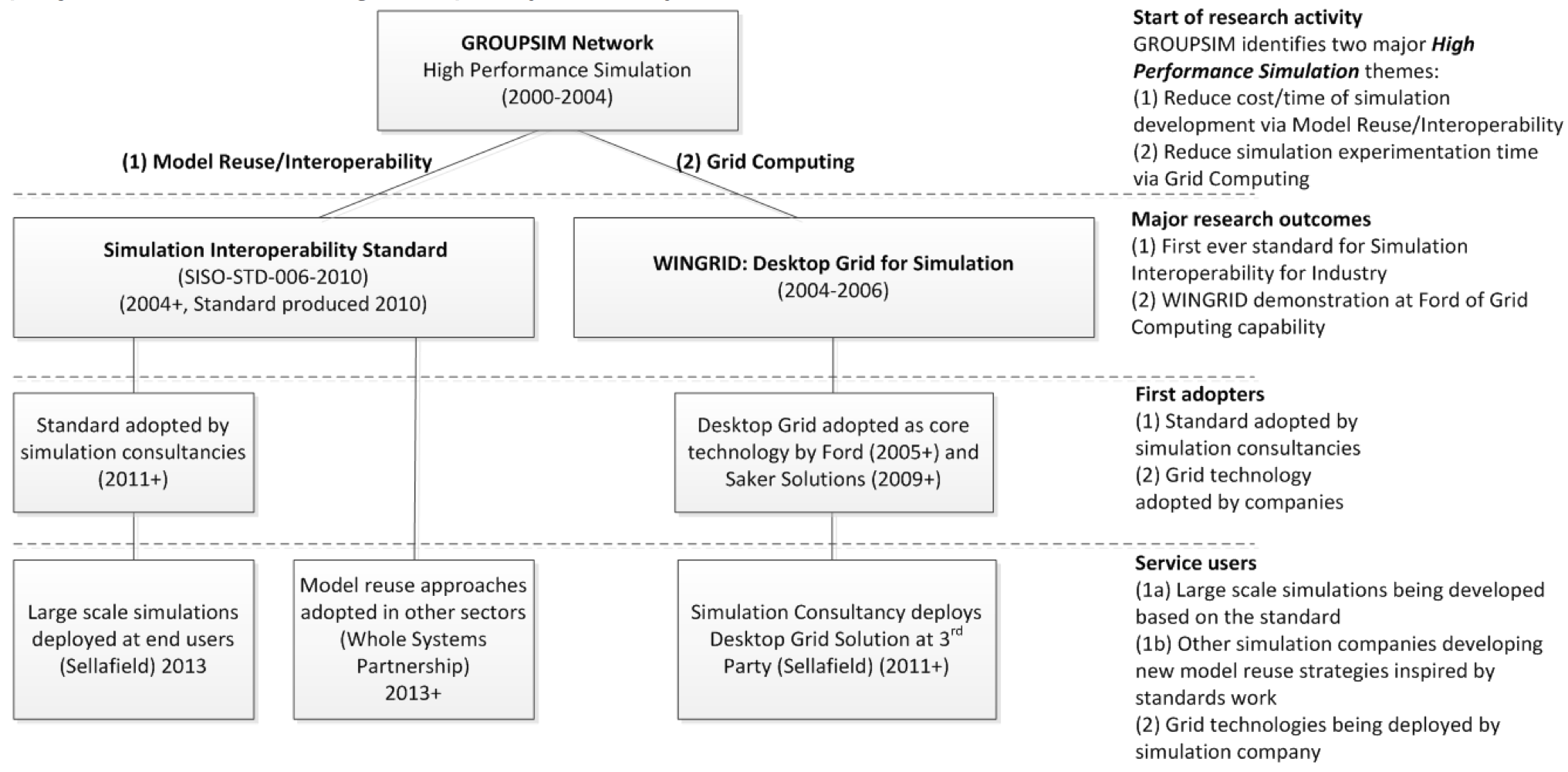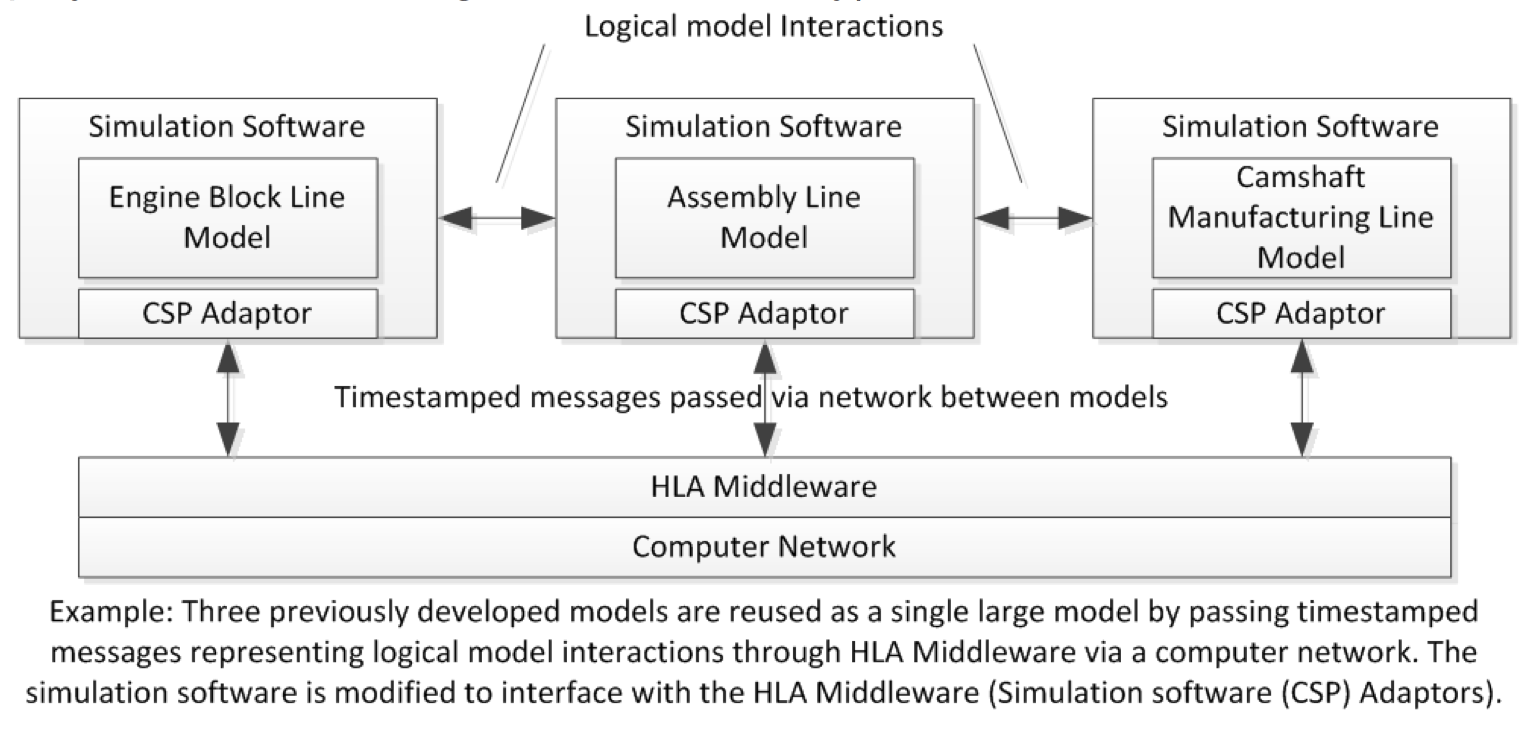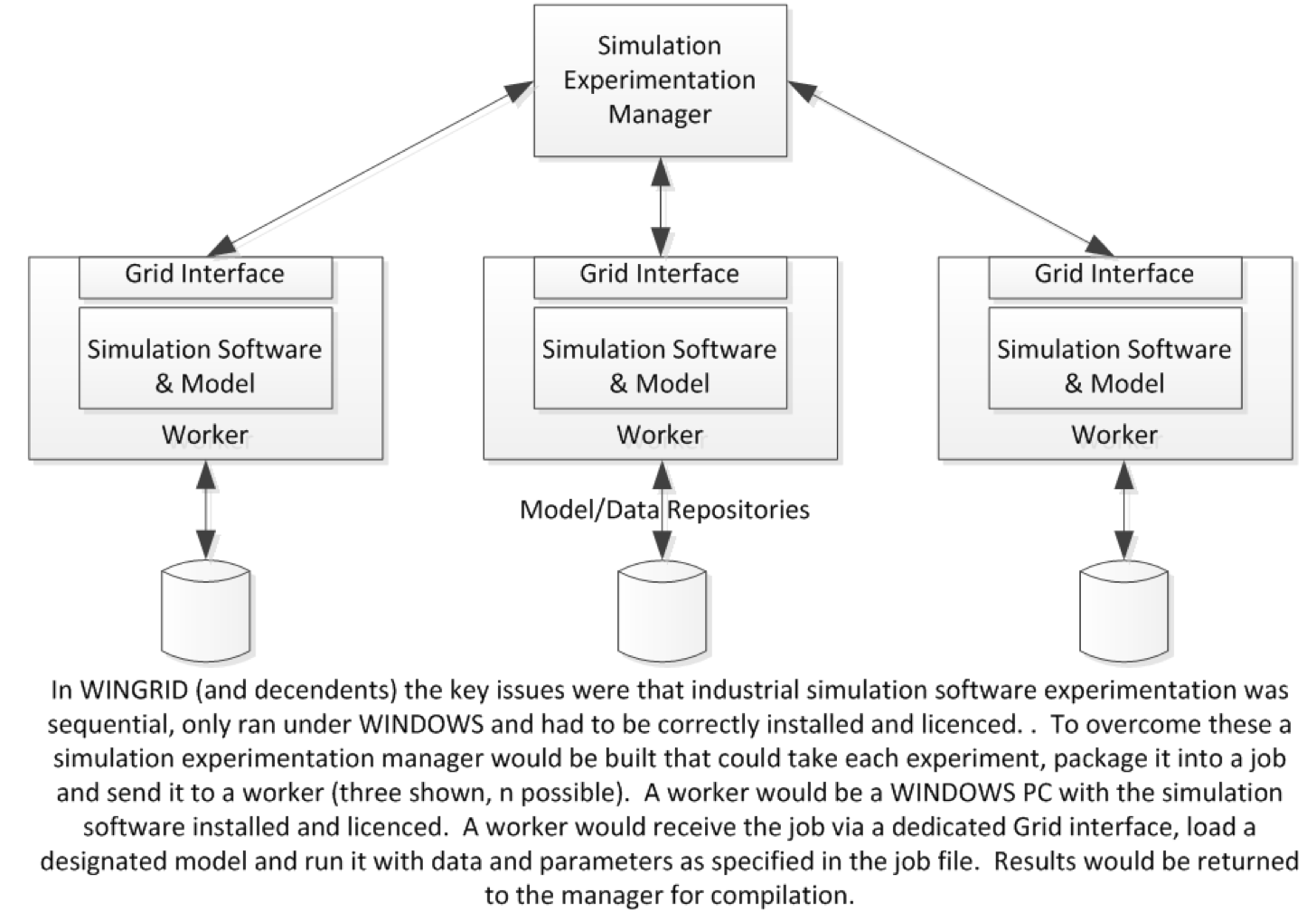High Performance Simulation techniques to reduce industrial production and logistics costs through better management
Submitting Institution
Brunel UniversityUnit of Assessment
Computer Science and InformaticsSummary Impact Type
TechnologicalResearch Subject Area(s)
Information and Computing Sciences: Artificial Intelligence and Image Processing, Computer Software, Information Systems
Summary of the impact
The research has enabled industrial simulation users to investigate and
develop larger scale systems faster and cheaper and thus
to explore a wider variety of cost-saving options with more precision,
and industrial simulation providers to offer new high-performance
simulation (HPS) products and services. As a direct result of this work:
Ford has made £150,000 cost savings in consultancy and significant process
improvements to engine manufacture globally; Saker Solutions (UK SME) has
created the first ever HPS system for production and logistics; Sellafield
PLC has used this system to make significant process improvements and
savings in the management of nuclear waste reprocessing of around £200,000
per year; and Whole Systems Partnership (a UK SME) used a spin-off from
this research to generate a £200,000 per year revenue stream from
interoperable healthcare decision support systems. Globally, several other
companies are adopting the standardisation efforts and other outcomes of
the research as the foundation for future innovation.
Underpinning research
Discrete-event simulation is used to investigate and improve planned or
existing industrial production and logistics systems (e.g., car engine
manufacturing plants, nuclear waste disposal, etc.). However, the
state-of-the-art of simulation technology limits the size of system being
studied and the amount of investigation that can be done in a project.
Models are also costly to develop, so it is desirable to reuse models as
`building blocks' in analysing larger systems. For example, an engine
manufacturing system model might be composed of several reused
interoperable models that represent the production of engine blocks,
camshafts, assembly lines, etc. Reusing these models to compose a larger
model clearly saves costs as there is significant investment in each
individual model. There are, though, major barriers to such composability
and interoperability that limit the size of model that can be developed.
Simulations also take time to run (minutes to hours depending on
complexity/size), and a systematic investigation could require many
thousands of simulation runs (and therefore potentially thousands of
hours). In practice, projects have limited time and budgets, so only a
subset of simulation experiments can be carried out in a specific
project/context, limiting the quality of study outcomes as a result.
 Figure 1: High Performance Simulation Impact Overview
Figure 1: High Performance Simulation Impact Overview
Solutions to the above problems were evident in other simulation domains,
but did not exist for industrial discrete-event simulation users. In 2000,
Taylor (a Senior Lecturer at Brunel at the time, now a Reader) led the
EPSRC Network GROUPSIM (EPSRC GR/N35304, 2000-2004) to investigate methods
to transfer these innovations into this industrial simulation sector to
make a step change in the state-of-the-art. These High Performance
Simulation techniques have two major complementary themes: (1) techniques
to reduce the cost and time of simulation development and (2) techniques
to reduce the time of simulation experimentation. The path to impact of
the research is shown in Figure 1.
(1) The defence simulation sector had successfully created an
approach to model reuse that linked together (interoperated) models over a
computer network (Figure 2) and thus made major cost savings in model
development by reusing previously developed models. This was based around
the IEEE 1516 High Level Architecture (HLA) standard for simulation
interoperability. GROUPSIM identified that there were major barriers to
using the HLA and related software (middleware) for production and
logistics simulation and that further standardisation was needed. In 2004,
Taylor led this standardisation effort by creating the international COTS
Simulation Package Interoperability Standards Development Group under the
US-based Simulation Interoperability Standards Organization (SISO). In
2010, derived directly from concepts introduced by Taylor in GROUPSIM, he
developed the world's first standard in this area, the Standard for
COTS Simulation Package Interoperability Reference Models
(SISO-STD-006-2010) (validated by SISO standards development process
following repeated community balloting). This is being used, for example,
to underpin large-scale simulation of nuclear waste management at
Sellafield (developed by Saker Solutions) and has been adopted by several
companies (e.g., AEGIS Technologies (USA), PITCH (Sweden), Simul8 (UK) and
D-SIMLAB (Singapore)). To demonstrate the approach and to avoid
proprietary model and data issues, a generic healthcare-based production
and logistics simulation was also created with related software developed
to support simulation interoperability by Taylor and Mustafee (PhD
Student, then Research Fellow, at Brunel 2004-9; now a lecturer at the
University of Exeter) (e.g., simulation software adaptors developed for
the well-known Simul8 software). A novel model reuse strategy has also
been developed with Whole Systems Partnership under a Knowledge Transfer
Programme (Taylor as lead academic) for Systems Dynamics Decision Support
in Healthcare (KTP008757) (Manpower capability planning) (currently
deployed at Trent Strategic Health Authority).
 Figure 2: Model Reuse Via Simulation Interoperability
Figure 2: Model Reuse Via Simulation Interoperability
(2) In other areas, Grid Computing (the use of multiple computers
to speed up applications) has had a major impact. However, at the time,
Grid Computing technologies could not be easily utilised by most
simulation software used for production and logistics simulation. To
demonstrate how Grid Computing could be used in this area, Taylor with
Mustafee developed WINGRID (2004-2006) — the WINDOWS-based Desktop Grid
for Simulation (Figure 3). This was successfully deployed at the Ford
Motor Company's Dunton Engineering Centre (Brentwood, Essex) to
investigate engine system manufacturing worldwide. At Ford this system has
evolved and is now a core simulation technology. Experience from this work
led to the development of SAKERGRID which supports high speed simulation
at Saker Solutions, a UK simulation consultancy with a wide range of
production and logistics projects. SakerGrid has, in turn, been deployed
at Sellafield to support the high speed simulation of nuclear waste
management.
 Figure 3: WINGRID Desktop Grid Architecture
Figure 3: WINGRID Desktop Grid Architecture
References to the research
[1] Taylor, S.J.E., Turner, S.J. and Strassburger, S. (2010). Standard
for COTS Simulation Package Interoperability Reference Models
(SISO-STD-006-2010), Simulation Interoperability Standards Organization,
Orlando, Florida, USA.
[2] Taylor, S.J.E. Developing Strategies and Infrastructure for
Collaborative Simulation Modelling (GROUPSIM). EPSRC (GR/N35304).
Publications
[3] Taylor, S.J.E., Turner, S.J., Strassburger, S. and Mustafee, N.
(2012). Bridging The Gap: A Standards-Based Approach to OR/MS Distributed
Simulation. ACM Transactions on Modeling and Computer Simulation.
22(4). Article 18. http://dx.doi.org/10.1145/2379810.2379811
[4] Mustafee, N., Taylor, S.J.E., Katsaliaki, K., Dwivedi, Y.K. and
Williams, M. D. (2012). Motivations and Barriers in using Distributed
Supply Chain Simulation. International Transactions in Operational
Research. 19(5): 733-751. http://dx.doi.org/10.1111/j.1475-3995.2011.00838.x
[5] Mustafee, N. and Taylor, S.J.E. (2009) Speeding up simulation
applications using WinGrid. Concurrency and Computation: Practice and
Experience, 21 (11), 1504-1523. http://dx.doi.org/10.1002/cpe.1401
[6] Katsaliaki, K., Mustafee, N., Taylor, S.J.E and Brailsford, S.
(2009). Comparing Conventional and Distributed Approaches to Simulation in
a Complex Supply-Chain Health System. Journal of the Operational
Research Society.60, pp. 43-51. http://dx.doi.org/10.1057/palgrave.jors.2602531
Details of the impact
The GROUPSIM Network began work that has led to major innovations in High
Performance Simulation for industrial discrete-event simulation users and
is facilitating the investigation and development of larger scale systems
faster and cheaper and now allows a wider variety
of cost-saving options to be explored with more precision. It also
has made it possible for industrial simulation providers to offer new
high-performance simulation (HPS) products and services. As shown
in Figure 1, these innovations have two major complementary themes: (1)
techniques to reduce the cost and time of simulation development (Model
Reuse and Interoperability) and (2) techniques to reduce the time of
simulation experimentation (Grid Computing). The impact of each theme is
detailed below.
The standardisation efforts involved in (1) began in 2004 with the
formation of the standards development group (CSPI PDG) at SISO and
produced the first standard in 2010. The standard is now being gradually
adopted by the international practitioner community and is being used to
guide the development of large-scale manufacturing simulations. Saker
Solutions was involved in the development of the standard and is now using
the standard to create a large-scale simulation of nuclear waste
reprocessing at Sellafield PLC which has led to "major cost savings" (see
corroborating source S1). This is the first time that Sellafield has been
able to comprehensively study the major elements of waste management as a
whole system and is a direct output of both the standard and the
standardisation process. Examples of practitioners adopting the standard
internationally are: AEGIS Technologies (a USA SME specialising in defence
simulation), PITCH (an SME based in Sweden that develops large scale
simulations), Simul8 (a UK SME that sells one of the most well-known
simulation software) and D-SIMLAB (a Singapore SME specialising in
aircraft maintenance logistics). (Corroborating source S2 from Mark Elder,
Chairman of Simul8, is representative of this adoption, "Without this
we and the whole simulation industry would still be operating in an
isolated way").
The Grid Computing development work in (2) has been adopted by several
simulation users. At the Ford Motor Company's Dunton Engineering Centre
(Brentwood, Essex) simulation is used to design engine manufacturing
facilities worldwide and for process improvement in day-to-day operations
by studying different machine configurations, buffer capacities,
changeover Schemes, etc. Brunel and Ford developed various High
Performance Simulation solutions for implementation in Ford's Power Train
Manufacturing simulation team. Ford has adopted and built new high
performance simulation systems in conjunction with Lanner Group (a
simulation consultancy SME). Ford now uses significantly more simulation
in this area and has saved an estimated £150,000 in consultancy cost
during the REF period and, according to Ford's Technical specialist, a
significant undisclosable sum due to process improvements as a result of
that extra experimentation (see corroborating source S3). Dunton leads
simulation activities in this area worldwide and this work has therefore
affected production teams at Ford's engine manufacturing facilities across
the world (UK, USA, Mexico, Spain, South Africa and Brazil) (see
corroborating source S3).
Experiences from this enabled Taylor to lead the development of SAKERGRID
(in 2010) with Saker Solutions (one of around 10 UK SMEs specialising in
simulation), Grid Computing software supporting high speed experimentation
and test/build development. Saker Solutions employs 12 people (annual
turnover £1 to £2 million) in the UK and works with many UK companies
using simulation to study a wide range of manufacturing, production and
logistic problems. SAKERGRID has been used to significantly improve the
quality of Saker's simulation projects and is saving around £20,000 per
annum in terms of project time saved at Saker (£80,000 over 4 years) (see
corroborating source S1). Saker Solutions has now implemented SAKERGRID
(in 2011) within the Sellafield Ltd Operational Research Group (around 25
members) where the tool has been used since to support over 10 major
projects in the last year. The expected direct savings in this financial
year at Sellafield Ltd are approximately £200,000 with substantial
additional savings expected in subsequent years. Of course, in addition
there are unquantified savings arising from the reduced turnaround time of
experimentation enabled by the use of SAKERGRID which both reduces project
lead time and increases the number of scenarios which can be examined (see
corroborating source S4).
In terms of products and services, Saker Solutions is now able to offer
new high-speed products and services based on this work. Saker Solutions
is the first to offer these in a comprehensive manner. This has had a
`ripple effect' in the community and has led to at least one further
innovation due to the impact of these advanced in simulation technology
state of the art. This took the form of a Knowledge Transfer Partnership
(KTP) between Whole Systems Partnership and Brunel University (Taylor).
Whole Systems Partnership is a small consultancy with a £300,000 per year
turnover that develops healthcare decision support solutions. The results
of the KTP are a (from 2013 onward) £200,000 per year revenue stream using
reusable Systems Dynamics models for decision support in manpower
capability planning in the NHS (see corroborating source S5).
Sources to corroborate the impact
S1 - Letter received from Managing Director, Saker Solutions
S2 - Letter received from Founder and Non-executing Chair, Simul8
Corporation
S3 - Letter received from Simulation Technical Expert, Ford Motor Company
Ltd.
S4 - Letter received from Project Leader, Sellafield Operational Research
Group
S5 - Letter received from Managing Director, The Whole Systems
Partnership